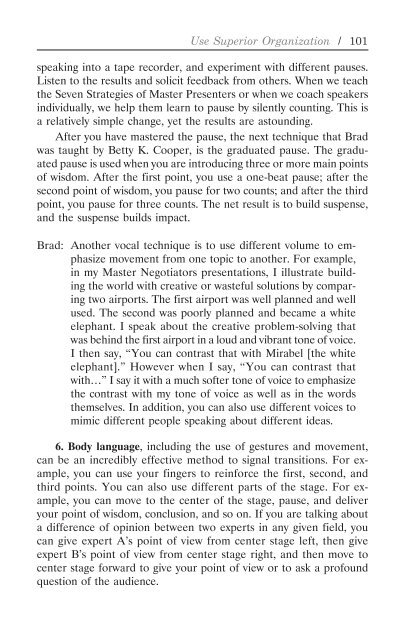The Seven Strategies of Master Presenters - Lifecycle Performance ...
The Seven Strategies of Master Presenters - Lifecycle Performance ...
The Seven Strategies of Master Presenters - Lifecycle Performance ...
You also want an ePaper? Increase the reach of your titles
YUMPU automatically turns print PDFs into web optimized ePapers that Google loves.
Use Superior Organization / 101<br />
speaking into a tape recorder, and experiment with different pauses.<br />
Listen to the results and solicit feedback from others. When we teach<br />
the <strong>Seven</strong> <strong>Strategies</strong> <strong>of</strong> <strong>Master</strong> <strong>Presenters</strong> or when we coach speakers<br />
individually, we help them learn to pause by silently counting. This is<br />
a relatively simple change, yet the results are astounding.<br />
After you have mastered the pause, the next technique that Brad<br />
was taught by Betty K. Cooper, is the graduated pause. <strong>The</strong> graduated<br />
pause is used when you are introducing three or more main points<br />
<strong>of</strong> wisdom. After the first point, you use a one-beat pause; after the<br />
second point <strong>of</strong> wisdom, you pause for two counts; and after the third<br />
point, you pause for three counts. <strong>The</strong> net result is to build suspense,<br />
and the suspense builds impact.<br />
Brad: Another vocal technique is to use different volume to emphasize<br />
movement from one topic to another. For example,<br />
in my <strong>Master</strong> Negotiators presentations, I illustrate building<br />
the world with creative or wasteful solutions by comparing<br />
two airports. <strong>The</strong> first airport was well planned and well<br />
used. <strong>The</strong> second was poorly planned and became a white<br />
elephant. I speak about the creative problem-solving that<br />
was behind the first airport in a loud and vibrant tone <strong>of</strong> voice.<br />
I then say, “You can contrast that with Mirabel [the white<br />
elephant].” However when I say, “You can contrast that<br />
with…” I say it with a much s<strong>of</strong>ter tone <strong>of</strong> voice to emphasize<br />
the contrast with my tone <strong>of</strong> voice as well as in the words<br />
themselves. In addition, you can also use different voices to<br />
mimic different people speaking about different ideas.<br />
6. Body language, including the use <strong>of</strong> gestures and movement,<br />
can be an incredibly effective method to signal transitions. For example,<br />
you can use your fingers to reinforce the first, second, and<br />
third points. You can also use different parts <strong>of</strong> the stage. For example,<br />
you can move to the center <strong>of</strong> the stage, pause, and deliver<br />
your point <strong>of</strong> wisdom, conclusion, and so on. If you are talking about<br />
a difference <strong>of</strong> opinion between two experts in any given field, you<br />
can give expert A’s point <strong>of</strong> view from center stage left, then give<br />
expert B’s point <strong>of</strong> view from center stage right, and then move to<br />
center stage forward to give your point <strong>of</strong> view or to ask a pr<strong>of</strong>ound<br />
question <strong>of</strong> the audience.










